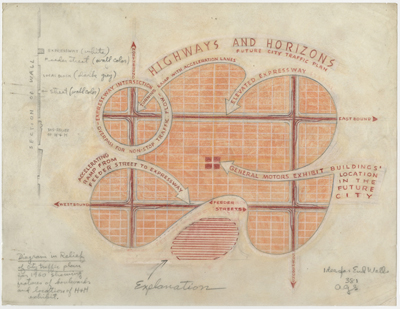
Forecasting the automobile’s ability to transform society, industrial designer Norman Bel Geddes planned his Futurama exhibition at the 1939–1940 New York World’s Fair around vehicular transportation systems. The Fair’s theme, “Building the World of Tomorrow,” provided an international stage for Bel Geddes to showcase his optimistic and auto-centric vision of the future American landscape. Bel Geddes, along with other modernist pioneers, crafted models, dioramas, and multimedia displays to provide Depression-era Americans with a brighter vision of the future.
Eager to shape national consciousness, Bel Geddes provided attendees of Futurama at the General Motors “Highways and Horizons” pavilion with a choreographed experience on the curvilinear thoroughfares of an imagined 1960 America. One of the World Fair’s most popular attractions, Futurama led exhibit-goers on model highways through a massive model city, complete with miniature buildings, trees, and streamlined automobiles. The holistic urban plan of Futurama borrowed from Bel Geddes’s earlier theater work, in which he created a dynamic and participatory environment for audience members.
Shown here is a 1938 “diagram in relief of city-traffic plan for 1960 showing features of boulevards and location of Highways & Horizons exhibit.” Tear-drop shaped highways bisect the model city and converge at the General Motors Exhibition Buildings, which housed Futurama. Proposing ways to alleviate traffic congestion and increase efficiency, Bel Geddes created imaginative traffic plans to route through-traffic around the city center.
Recognizing the growing importance of automobiles in American society, Bel Geddes modeled his Futurama around an intricate network of streamlined motorways. Futurama’s elevated pedestrian walks and interconnected highway systems would not only accommodate fast and more efficient modes of transportation but would also foster American egalitarianism through the linkage of rural and urban areas. Bel Geddes even fought “to keep large super-billboards off the highways in Futurama.”
With Futurama’s success, Bel Geddes pursued avenues to alter America’s fledgling car culture. Bel Geddes alerted President Franklin D. Roosevelt of Futurama’s “enormous popularity. . . as indicated by the nation-wide press use of the subject matter, and the consequent editorial comment.” In response, Roosevelt appointed Bel Geddes to work on preliminary plans for the National Motorway Planning Authority, which influenced the interstate highway system of the 1950s.
This diagram of a city-traffic plan for 1960 is on view in the exhibition I Have Seen the Future: Norman Bel Geddes Designs America, which runs through January 6, 2013.
